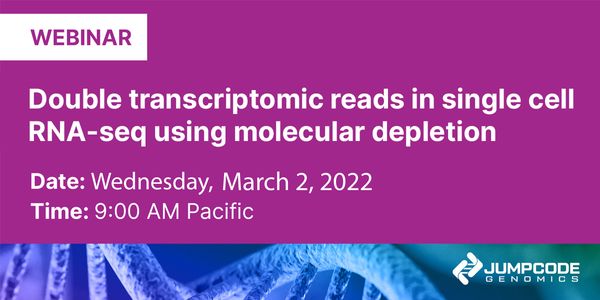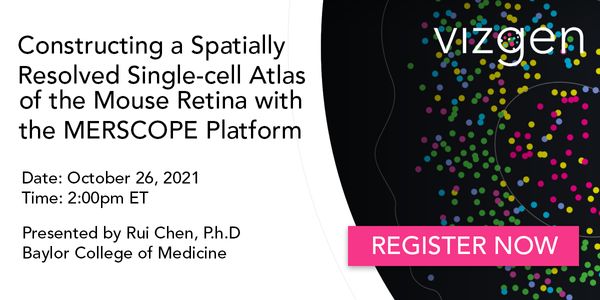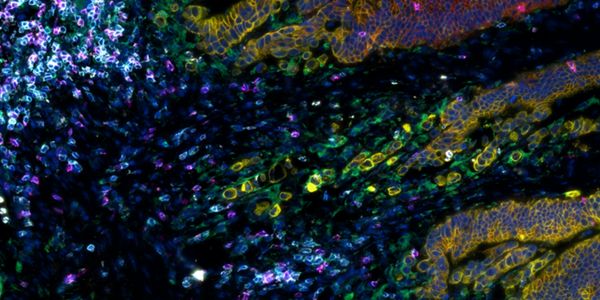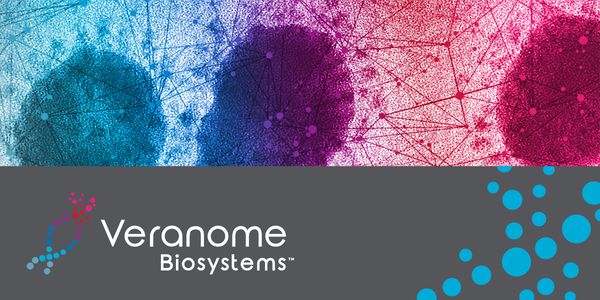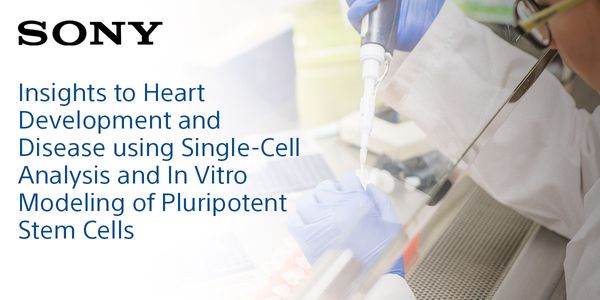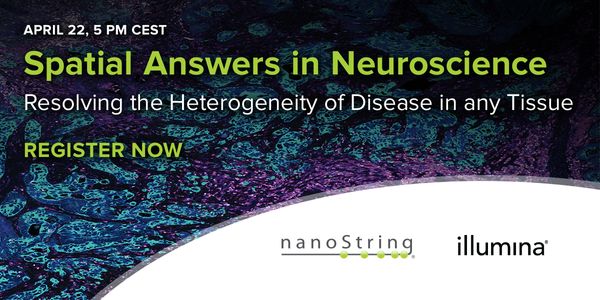Transcriptome
The transcriptome is the complete set of all RNA molecules in a cell, a population of cells or in an organism. Researchers can determine when and where each gene is turned on or off in the cells and tissues of an organism after analyzing the entire collection of RNA sequences in a cell.
-
MAR 31, 2022 | 11:00 AMDate: March 31, 2022 Time: 11:00am (PDT), 2:00pm (EDT), 8:00pm (CET) Formalin-fixed paraffin-embedded (FFPE) tissues are the most widely used clinical sample types in histology and molecular...MAR 10, 2022 | 7:30 AMNanoString has started an ambitious project called the "Spatial Organ Atlas." The goal of this initiative is to map the architecture of tissues with spatially resolved whole transc...Speaker: Alison VanSchoiack, PhDMAR 02, 2022 | 9:00 AMDate: March 02, 2022 Time: 9:00am (PST), 12:00pm (EST) Single cell RNA-seq is known to only capture a small fraction of the transcriptome of each cell. Often, this is due to inherent limitat...FEB 23, 2022 | 1:30 PMHigh-throughput sequencing technology such as RNASeq and whole genome sequencing has enabled deep characterization of health and disease states. Biomarker discovery by these means has only h...Speaker: Esperanza Anguiano, PhD, MS-MBAPresented at: Drug Discovery & Development Virtual Event Series 2022
Sponsored By: NanoString TechnologiesOCT 27, 2021 | 10:00 AMDate: October 27, 2021 Time: 10:00am (PDT), 1:00pm (EDT) The COVID-19 pandemic has brought global awareness to the dangers of emerging pathogens to human health and welfare. Common molecular...OCT 26, 2021 | 11:00 AMDate: October 26, 2021 Time: 11:00am (PDT), 1:00pm (EDT) The retina is the light-sensing part of the visual system and is composed of six neuron types and several non-neuronal cell types, wi...OCT 21, 2021 | 7:00 AMDate: October 21, 2021 Time: 7:00am (PDT), 10:00am (EDT) To simultaneously visualize multiple markers within the same sample enables a more detailed view of cellular phenotypes and how they...OCT 13, 2021 | 10:30 AMSevere SARS-CoV-2 infection often leads to development of acute respiratory distress syndrome (ARDS), with profound pulmonary patho-histological changes post-mortem. In this study, we utiliz...Speaker: Camilla Margaroli, PhDSEP 29, 2021 | 9:00 AMRNA plays important and diverse roles in biology, but molecular tools to manipulate and measure RNA are limited. We demonstrate that RNA-targeting CRISPR effector Cas13 and novel RNA targeti...Speaker: Omar Abudayyeh, PhD , Jonathan Gootenberg, PhDPresented at: CRISPR Virtual Event Series 2021
AUG 25, 2021 | 1:30 PMTechnological advances such as single-cell RNA sequencing accelerated our understanding of cellular diversity in tissues. However, the ability to elucidate this cellular heterogeneity while...Speaker: Jeroen Aerts, PhDAUG 25, 2021 | 1:30 PMIn this preliminary experiment, we used spatial transcriptomics to assess the gene expression profiles of microglia or astrocytes in relation to their distance from plaques. We compared 18-m...Speaker: Frances Edwards, PhDAUG 25, 2021 | 12:00 AMMultiscale modeling has arisen as a focus of computational systems biology, with the realization that genome, proteome, connectome, etceteromes, will only become comprehensible once placed i...JUL 15, 2021 | 9:00 AMDate: July 15, 2021 Time: 9:00am (PDT), 12:00pm (EDT) The Pisces workflow robust, easy-to-use, end-to-end multi-omics solution for highly multiplexed targeted Spatial RNA analysis. VeranomeB...JUN 24, 2021 | 8:00 AMDate: June 24, 2021 Time: 8:00am (PDT), 11:00am (EDT) Cardiovascular disease is a leading health problem, affecting almost 30% of individuals in the developed world, and comprises a wide ran...APR 22, 2021 | 10:30 AMNucleic acid amplification tests (NAAT) are a reliable, sensitive, and accurate diagnostic approach used in viral detection. The approach involves the isolation of nucleic acids from a sampl...Speaker: Donald GreenPresented at: Genetics Week Virtual Event Series 2021
Sponsored By: Pall Medical, now a part of CytivaAPR 22, 2021 | 5:00 PMDate: April 22, 2021 Time: 8:00am (PDT), 11:00am (EDT), 5:00pm (CEST) System transcriptomics of the schizophrenia brain - Phillip Khaitovich Schizophrenia tops the psychiatric disorder l...APR 21, 2021 | 5:00 PMDate: April 21, 2021 Time: 8:00am (PDT), 11:00am (EDT), 5:00pm (CEST) Spatial Answers Trilogy - Spatial Answers in Immunology Immunology Researchers share their Spatial Discoveries in SARS-C...Speaker: Doug Brown, PhD , Susanne Krasemann, MD, PhD , Michelle Naughton, PhDSponsored By: NanoString Technologies, IlluminaAPR 20, 2021 | 4:30 PMC.E. CREDITSCOVID-19 is a severe disease that has caused >1 million deaths in under one year. As this disease is novel, the molecular and cellular underpinnings of the progressive tissue injury are p...Speaker: Christopher Mason, Ph.DAPR 20, 2021 | 1:30 PMRevolutionary sequencing technologies are enabling whole transcriptome profiling of tens to hundreds of thousands of single cells in parallel, in a single experiment. This has led to an expl...Speaker: Carina Emery , Alina SteinbachAPR 20, 2021 | 5:00 PMDate: April 20, 2021 Time: 8:00am (PDT), 11:00am (EDT), 5:00pm (CEST) Spatial Answers on Oncology - Professor Joan Seoane Prof. Joan Seoane, Group Leader and Director of the Translational Re...Speaker: Noel De Miranda , Vasilis Stavrinides, MDSponsored By: NanoString Technologies, IlluminaAPR 20, 2021 | 12:00 AMTraumatic brain injury (TBI) is best characterized as brain dysfunction caused by an outside force, usually a violent blow to the head, often occurring as a result of a severe sports injury...APR 20, 2021 | 12:00 AMLearning Objectives: 1. Learn about alternative promoters and their role in cancer 2. Learn how long read RNA-Seq helps to study the transcriptome...APR 20, 2021 | 12:00 AMLearning Objectives: 1. Demonstrate the utility of long-read RNA-sequencing in studying alternative isoforms 2. Define the long-Split-seq approach to profiling the transcriptomes of single-c...APR 20, 2021 | 12:00 AMLearning Obejctives: 1. Understand the key requirements for sample preparation in a single cell and/or spatial transcriptomics experiment 2. Learn the synergies between a combined single cel...
MAR 31, 2022 | 11:00 AM
Date: March 31, 2022 Time: 11:00am (PDT), 2:00pm (EDT), 8:00pm (CET) Formalin-fixed paraffin-embedded (FFPE) tissues are the most widely used clinical sample types in histology and molecular...
MAR 10, 2022 | 7:30 AM
NanoString has started an ambitious project called the "Spatial Organ Atlas." The goal of this initiative is to map the architecture of tissues with spatially resolved whole transc...
Speaker:
Alison VanSchoiack, PhD
MAR 02, 2022 | 9:00 AM
Date: March 02, 2022 Time: 9:00am (PST), 12:00pm (EST) Single cell RNA-seq is known to only capture a small fraction of the transcriptome of each cell. Often, this is due to inherent limitat...
FEB 23, 2022 | 1:30 PM
High-throughput sequencing technology such as RNASeq and whole genome sequencing has enabled deep characterization of health and disease states. Biomarker discovery by these means has only h...
Speaker:
Esperanza Anguiano, PhD, MS-MBA
Presented at: Drug Discovery & Development Virtual Event Series 2022
Sponsored By: NanoString Technologies
Sponsored By: NanoString Technologies
OCT 27, 2021 | 10:00 AM
Date: October 27, 2021 Time: 10:00am (PDT), 1:00pm (EDT) The COVID-19 pandemic has brought global awareness to the dangers of emerging pathogens to human health and welfare. Common molecular...
OCT 26, 2021 | 11:00 AM
Date: October 26, 2021 Time: 11:00am (PDT), 1:00pm (EDT) The retina is the light-sensing part of the visual system and is composed of six neuron types and several non-neuronal cell types, wi...
OCT 21, 2021 | 7:00 AM
Date: October 21, 2021 Time: 7:00am (PDT), 10:00am (EDT) To simultaneously visualize multiple markers within the same sample enables a more detailed view of cellular phenotypes and how they...
OCT 13, 2021 | 10:30 AM
Severe SARS-CoV-2 infection often leads to development of acute respiratory distress syndrome (ARDS), with profound pulmonary patho-histological changes post-mortem. In this study, we utiliz...
Speaker:
Camilla Margaroli, PhD
SEP 29, 2021 | 9:00 AM
RNA plays important and diverse roles in biology, but molecular tools to manipulate and measure RNA are limited. We demonstrate that RNA-targeting CRISPR effector Cas13 and novel RNA targeti...
Speaker:
Omar Abudayyeh, PhD
, Jonathan Gootenberg, PhD
Presented at: CRISPR Virtual Event Series 2021
AUG 25, 2021 | 1:30 PM
Technological advances such as single-cell RNA sequencing accelerated our understanding of cellular diversity in tissues. However, the ability to elucidate this cellular heterogeneity while...
Speaker:
Jeroen Aerts, PhD
AUG 25, 2021 | 1:30 PM
In this preliminary experiment, we used spatial transcriptomics to assess the gene expression profiles of microglia or astrocytes in relation to their distance from plaques. We compared 18-m...
Speaker:
Frances Edwards, PhD
AUG 25, 2021 | 12:00 AM
Multiscale modeling has arisen as a focus of computational systems biology, with the realization that genome, proteome, connectome, etceteromes, will only become comprehensible once placed i...
JUL 15, 2021 | 9:00 AM
Date: July 15, 2021 Time: 9:00am (PDT), 12:00pm (EDT) The Pisces workflow robust, easy-to-use, end-to-end multi-omics solution for highly multiplexed targeted Spatial RNA analysis. VeranomeB...
JUN 24, 2021 | 8:00 AM
Date: June 24, 2021 Time: 8:00am (PDT), 11:00am (EDT) Cardiovascular disease is a leading health problem, affecting almost 30% of individuals in the developed world, and comprises a wide ran...
APR 22, 2021 | 10:30 AM
Nucleic acid amplification tests (NAAT) are a reliable, sensitive, and accurate diagnostic approach used in viral detection. The approach involves the isolation of nucleic acids from a sampl...
Speaker:
Donald Green
Presented at: Genetics Week Virtual Event Series 2021
Sponsored By: Pall Medical, now a part of Cytiva
Sponsored By: Pall Medical, now a part of Cytiva
APR 22, 2021 | 5:00 PM
Date: April 22, 2021 Time: 8:00am (PDT), 11:00am (EDT), 5:00pm (CEST) System transcriptomics of the schizophrenia brain - Phillip Khaitovich Schizophrenia tops the psychiatric disorder l...
APR 21, 2021 | 5:00 PM
Date: April 21, 2021 Time: 8:00am (PDT), 11:00am (EDT), 5:00pm (CEST) Spatial Answers Trilogy - Spatial Answers in Immunology Immunology Researchers share their Spatial Discoveries in SARS-C...
Speaker:
Doug Brown, PhD
, Susanne Krasemann, MD, PhD
, Michelle Naughton, PhD
Sponsored By: NanoString Technologies,
Illumina
APR 20, 2021 | 4:30 PM
C.E. CREDITS
COVID-19 is a severe disease that has caused >1 million deaths in under one year. As this disease is novel, the molecular and cellular underpinnings of the progressive tissue injury are p...
Speaker:
Christopher Mason, Ph.D
APR 20, 2021 | 1:30 PM
Revolutionary sequencing technologies are enabling whole transcriptome profiling of tens to hundreds of thousands of single cells in parallel, in a single experiment. This has led to an expl...
Speaker:
Carina Emery
, Alina Steinbach
APR 20, 2021 | 5:00 PM
Date: April 20, 2021 Time: 8:00am (PDT), 11:00am (EDT), 5:00pm (CEST) Spatial Answers on Oncology - Professor Joan Seoane Prof. Joan Seoane, Group Leader and Director of the Translational Re...
Speaker:
Noel De Miranda
, Vasilis Stavrinides, MD
Sponsored By: NanoString Technologies,
Illumina
APR 20, 2021 | 12:00 AM
Traumatic brain injury (TBI) is best characterized as brain dysfunction caused by an outside force, usually a violent blow to the head, often occurring as a result of a severe sports injury...
APR 20, 2021 | 12:00 AM
Learning Objectives: 1. Learn about alternative promoters and their role in cancer 2. Learn how long read RNA-Seq helps to study the transcriptome...
APR 20, 2021 | 12:00 AM
Learning Objectives: 1. Demonstrate the utility of long-read RNA-sequencing in studying alternative isoforms 2. Define the long-Split-seq approach to profiling the transcriptomes of single-c...
APR 20, 2021 | 12:00 AM
Learning Obejctives: 1. Understand the key requirements for sample preparation in a single cell and/or spatial transcriptomics experiment 2. Learn the synergies between a combined single cel...



